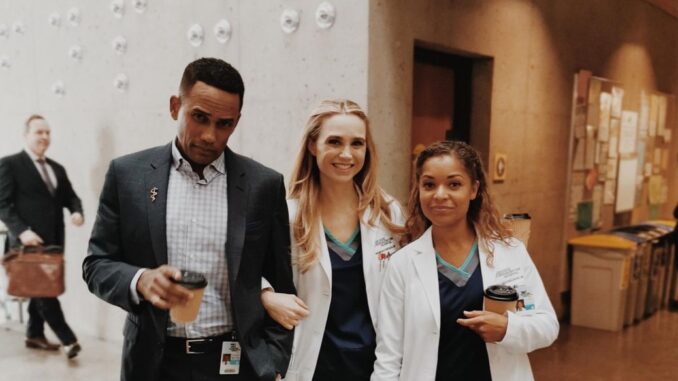
When Dr. Shaun Murphy first walked into the boardroom of San Jose St. Bonaventure Hospital, he wasn’t met with applause or admiration. He wasn’t celebrated as a prodigy. He was doubted. Questioned. Rejected.
He wasn’t what the hospital expected in a surgical resident. He didn’t shake hands. He didn’t make eye contact. He didn’t respond to small talk or understand sarcasm. He was awkward. His presence made people uncomfortable. And yet, Shaun was there with one goal: to save lives.
The Good Doctor begins not with a triumph, but with resistance. From the moment Shaun arrives, he is met with skepticism. The hospital board doesn’t believe he can function in the high-pressure environment of a surgical team. Colleagues wonder if he can connect with patients. Even his mentor, Dr. Glassman, faces backlash for believing in him.
But then something happens.
A boy at the airport collapses. The crowd panics. Paramedics are minutes away. Shaun sees what no one else does. A life-threatening condition, a rare and fatal internal injury that needs immediate action. With only a pocket knife, a tube, and medical knowledge far beyond his years, Shaun performs an emergency procedure and saves the boy’s life.

That moment changes everything.
The hospital board watches the footage. The media calls it a miracle. And just like that, the doctor no one believed in becomes the doctor no one can ignore.
But The Good Doctor doesn’t stop at that miraculous save. That moment is just the beginning of a series that takes us deep into Shaun’s world—where every diagnosis is a puzzle, every surgery a test of skill and resolve, and every interaction a challenge in communication, trust, and humanity.
What makes Shaun’s journey so powerful is not just his medical brilliance, though that alone would make him remarkable. It’s his emotional resilience. Despite constant judgment, he keeps showing up. Despite isolation, he keeps trying to connect. Despite the odds, he keeps fighting for a place in a system that was not built for someone like him.
In many ways, The Good Doctor is about more than medicine. It’s about recognition. About the hunger we all have to be seen and accepted—not for who we appear to be, but for who we truly are. Shaun doesn’t want pity. He doesn’t want special treatment. He wants to be held to the same standard as everyone else. He wants the opportunity to prove his worth through action.
And prove it he does.
Throughout the seasons, viewers witness Shaun solving medical cases that baffle even the most experienced doctors. He notices patterns in lab results that others miss. He recalls obscure case studies from years ago that apply perfectly to current crises. He asks questions others are afraid to ask. And often, he risks his reputation and position by speaking truths no one wants to hear.
But the show doesn’t paint him as flawless. Shaun makes mistakes. Sometimes his literal thinking leads to miscommunication. Sometimes his lack of emotional expression causes pain. Sometimes he’s insensitive without knowing it. And yet, The Good Doctor refuses to reduce him to a trope. He’s not “the quirky genius.” He’s not “the outsider with a gift.” He’s a complex, evolving person with real emotions, needs, and dreams.
One of the most compelling parts of the series is watching how those around Shaun change. Dr. Claire Browne, one of the first to accept and support him, becomes his emotional anchor in the early seasons. Dr. Melendez, initially skeptical, grows to respect Shaun not just for his talent, but for his heart. Dr. Andrews, who once fought against Shaun’s hiring, becomes one of his fiercest defenders.
Each relationship in the show is crafted with care and nuance. Whether it’s friendship, mentorship, or rivalry, the dynamic between Shaun and the people around him challenges every stereotype we hold about ability, neurodiversity, and leadership.
As the show progresses, Shaun begins to explore aspects of life he never thought possible. He falls in love. He navigates romantic relationships—both the beauty and the heartbreak. He struggles with vulnerability, jealousy, and fear. He learns to communicate better, to compromise, to forgive. And in doing so, he becomes more than a brilliant doctor—he becomes a fully realized human being.
What makes The Good Doctor stand out in a landscape of medical dramas is its balance between head and heart. It gives us the adrenaline of a trauma room, the thrill of a rare diagnosis, and the intellectual satisfaction of solving medical mysteries. But it also gives us something more: a portrait of what it means to be human in all its messy, difficult, and beautiful complexity.
At its core, the series asks a simple question: What makes a good doctor? Is it technical skill? Compassion? The ability to comfort patients? The respect of peers? Or is it something more intangible—like the courage to face rejection, the strength to be different, and the unrelenting drive to save lives no matter the cost? He is not the doctor people expected. But he is the doctor they needed. And that’s why millions of viewers around the world keep coming back—episode after episode—not just for the medical drama, but for the story of one man who refused to be defined by his diagnosis.
